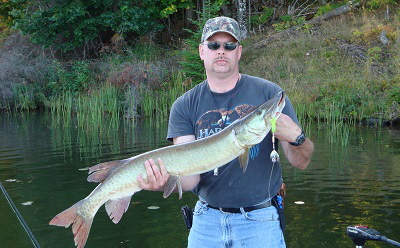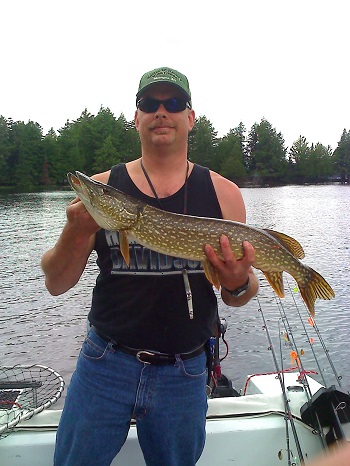|
|
|
|
 |
Mikeís Muskie Fishing Tips
Keep in mind this is a very general outline. As we all know, daily weather and water conditions vary everyday of every season.
Springtime to early summer - cool but increasingly warmer water
1. Cast shallow running crank baits at weed edges adjacent to shore and retrieve from weed edge towards boat allowing the lure to drop into the shallow water column outside the weed edge, and continue to retrieve.
|
|
 |
 |
|
2. Cast bladed inline lured (e.g. Tawnter, Bucktails, Spinner Baits) all the way to shore over weed beds, fallen timbers, next to boat docks, rocky shore points and retrieve at a fast enough pace to be just over the top of the newly formed weeds, or over top of fallen lumber all the way back to the boat. Most importantly, donít jerk the lure out of the water at the end of the retrieve, let in dangle in the water for a few seconds before lifting out of the water. Many strikes occur at the end of the retrieve.
3. Utilize a fall technique, just use a faster retrieve. Cast a floating jerk bait (e.g. Suick, Bobbie bait) and cast over the same areas as the bladed lures. Retrieve in a pull-pause-reel-pull-pause-reel method all the way back to the boat, allowing the lure to float in the water a few seconds before lifting out for the next cast.
4. Live bait minnows. Use large chubs. Hook the minnow through the back just underneath the middle of the dorsal fin onto 3/8 oz. or 1/2 oz. jig beneath a large slip float or bobber setup. The float should be large enough to keep the minnow suspended about 6-10 inches off the bottom of weed pockets, shoreside or lakeside weed edges, or over submerged timber.
Summer Time - Warm to very warm water
Muskie will sometimes be found near shores, in weeds or fallen timber areas. But the larger fish tend to move towards open water weed beds and mid-lake rock piles surrounded by deeper water.
1. Inline bladed baits, spinner baits and prop baits are first choice because they can be retrieved in a quick fashion. Cast into emergent weeds and retrieve the lure quickly over the top of submerged weeds. Also steer the lure through gaps and channels in the weeds with a slight dangling pause before lifting the lure out for the next cast. When retrieving over weeds, as the lure reaches the weed edge let it fall and flutter down slightly and then continue a quick retrieve. Prop baits over weeds and work fast enough to keep a constant blurping sound coming from the blade on top of the water. This works very well around sunken timber and emergent reeds, also. Cast Inlines and Spinners over mid-lake rock humps and retrieve at a speed that allows the lure to stay 6 inches to 1 foot under the surface. This method also works well with large full body soft plastic gliders (e.g. Bull Dawgs or eels).
2. Crank baits and Large crank baits. Work the weed edges, mid-lake rock humps or rocky shores with rock points sticking out toward deeper water. With large crank baits, crank fast enough or troll to cause the lure to tap the bottom of 5 to 12 foot rock piles under the surface. Cast into the fallen timber that tapers quickly to deeper water so the lure can dive with the contour of the drop-offs and timber. Again, use this method for the large full bodied soft plastic gliders (e.g. Bull Dawgs or eels).
|
 |
 |
|
Fall - Slightly warm to cool and cooling to cold water
Be ready to put your time in here! As the water gets cooler, the fish become more lethargic. Most fishermen primarily switch to live suckers as the water becomes very cool, but conventional lures still work very well when worked through the water correctly. (We wonít be discussing sucker fishing at all.) Floating jerk baits will become the primary lure, with very large bladed inline lures (e.g. Tawnter Magnum, Cowgirls and bucktails), with diving crank baits used in shallow water as a last ditch effort to prompt a strike. For the most productive times in cold water, work the sun beaten sides of the waters!
1. Cast the jerk baits (e.g. 9 to 10 inch Suiks and Bobbie baits) over shallow dying weed beds and work back to the boat in a slow jerk-reel-jerk-reel-jerk-reel retrieve, making sure to leave the lure sit in the water at the boat on the end of your retrieve before the next cast. Work very large bladed inline lures over shallow dying weed beds with a very slow retrieve, keeping the rod tip high, so the lure rides just under the surface. Steer it through the gaps and channels in the weeds and wood, all the way back to the boat. Again, pause momentarily in the water before the next cast. Perform these same techniques over and through emergent and submerged timber.
2. Over mid-lake rock hump, sunken islands or deeper weeds, work the different aforementioned lures in the same fashion. If using a diving crank bait, make sure it is a large-lipped deep diving lure and cast it over the mid-lake rock humps (4 to 9 feet) and reel it back at a speed that allows it to bump the rocks with a slight pause-and-crank method all the way back to the boat. If trolling with the crank bait, motor forward at the very slowest speed possible to maintain a constant tapping of the rock bottom.
|
|
|
 |
Most importantly, make sure fishing stays fun!
|
|



